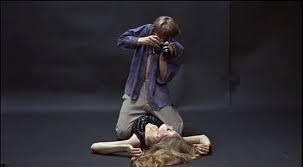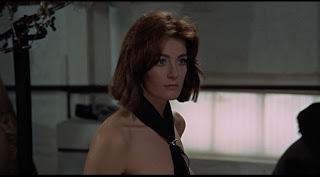
"Nothing like a little disaster for sorting things out."
Blow-Up (1966) has been a seminal text for cineastes and filmmakers for 50 years. Michelangelo Antonioni's English-language debut mates the opacity of his Italian films (L'Avventura, L'Eclisse) with the imagery and texture of Swinging London. It invites yet defies easy analysis, challenging viewers to engage it on its own terms.Thomas (David Hemmings) works as a fashion photographer, hobnobbing with high class models, indulging in abstract art and an open relationship with Patricia (Sarah Miles). Thomas photographs Jane (Vanessa Redgrave) and her lover in Maryon Park, with Jane panicking and attempting to buy the photos from him. But Thomas grows intrigued by her case, thinking that he's discovered evidence of a murder in the photos - but unable to prove it.
Blow-Up is tailor made for film school term papers, with meaning conveyed through mise-en-scene, camerawork and between-the-lines gestures and staging. Early scenes feature a troupe of mimes rampaging through London, introducing anarchy to the staid world of downtrodden workers, uptight nuns and uniformed Life Guards, with Thomas caught in the middle. Through him we experience both London's seamier side, the filthy pawn shops run-down industrial wastelands familiar from a dozen "kitchen sink" dramas, and the thrilling counterculture, where mod Brits boogie to the Yardbirds while toking reefers. Sex gives way to hedonism, with violence lurking around the corner.

Hence the central set piece, where Thomas stakes out Jane and her partner in a park, taking photographs even after they become aware of his presence. Initially a harmless lark, it becomes something more when Jane demands the photographs. Then he spends hours poring over the photographs, looking for hidden gunmen in the shadows like Oliver Stone scouring the Zapruder film. He's drawn into something neither he nor the audience fully comprehends, unable to find concrete evidence of an actual crime, or to convince anyone else what's happened. Ultimately he's left playing imaginary tennis with some mimes, in an ending as opaque as it is maddening.
Whether Blow-Up's studied, detached vagueness is engrossing or infuriating will depend on the viewer. My first viewing of the movie, many years ago, left me unsatisfied, though rewatching it brought out much texture that I appreciated: Antonioni's sparse, high-angle camerawork in the park, with Thomas and other figures fading away to nothing; Carlo Di Palma's compositions in Thomas's studio, framing the photographer and his subjects through screens like the abstract paintings Thomas admires; the unflattering emphasis on male gaze, the core of cinema since its inception. Still, compared to Francis Ford Coppola's The Conversation, which blends a similar mystery with a penetrating character study, it feels relatively lightweight.

If Hemmings' role is frustratingly underdeveloped, his costars seem like mere shadows. Game character actors Peter Bowles (as Hemmings' high-strung agent) and John Castle (as his partner) have glorified walk-ons, while Sarah Miles is reduced to gasping and making love with Castle. Vanessa Redgrave makes the most of a role centered on indignation and reluctant sensuality; her dignified bearing and angular beauty invests even such a marginal character with gravitas.
As an example of filmmaker's art, Blow-Up is top flight; as a meta examination of the darker impulses driving cinema, and art generally, it's fascinating. Yet as a movie, it still leaves me somewhat cold; puzzling out its abstractions proves more frustrating than rewarding.

